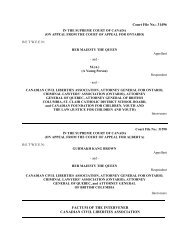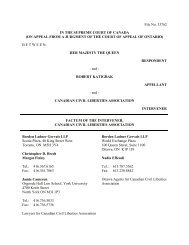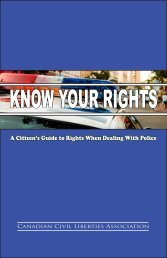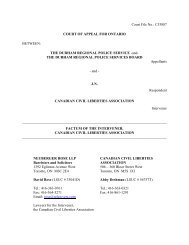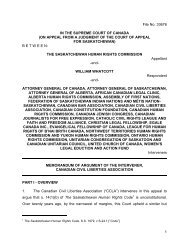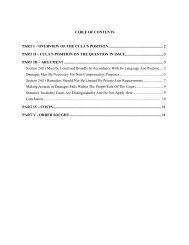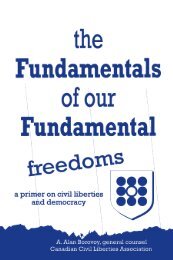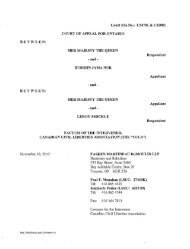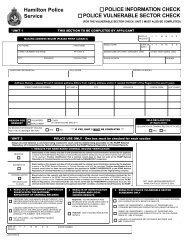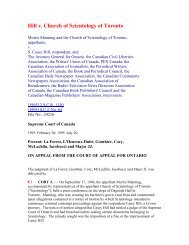ON APPEAL FROM THE COURT OF APPEAL OF ALBERTA
ON APPEAL FROM THE COURT OF APPEAL OF ALBERTA
ON APPEAL FROM THE COURT OF APPEAL OF ALBERTA
You also want an ePaper? Increase the reach of your titles
YUMPU automatically turns print PDFs into web optimized ePapers that Google loves.
IN <strong>THE</strong> SUPREME <strong>COURT</strong> <strong>OF</strong> CANADACourt File Number: 33186(<strong>ON</strong> <strong>APPEAL</strong> <strong>FROM</strong> <strong>THE</strong> <strong>COURT</strong> <strong>OF</strong> <strong>APPEAL</strong> <strong>OF</strong> <strong>ALBERTA</strong>)B E T W E E N:JAS<strong>ON</strong> MICHAEL CORNELLAppellant- and -HER MAJESTY <strong>THE</strong> QUEEN- and -RespondentATTORNEY GENERAL <strong>OF</strong> <strong>ALBERTA</strong>ATTORNEY GENERAL <strong>OF</strong> <strong>ON</strong>TARIOBRITISH COLUMBIA CIVIL LIBERTIES ASSOCIATI<strong>ON</strong>CANADIAN CIVIL LIBERTIES ASSOCIATI<strong>ON</strong>IntervenersFACTUM <strong>OF</strong> <strong>THE</strong> INTERVENER, CANADIAN CIVIL LIBERTIES ASSOCIATI<strong>ON</strong>MCCARTHY TÉTRAULT LLPSuite 5300, TD Bank TowerToronto, Ontario M5K 1E6Christopher A. WaylandTel: (416) 601-8109Fax: (416) 686-0673cwayland@mccarthy.caSarah R. ShodyTel: (416) 601-8319Fax:(416) 686-0673sshody@mccarthy.caCAVANAGH WILLIAMS C<strong>ON</strong>WAYBAXTER LLP1111 Prince of Wales DriveSuite 401Ottawa <strong>ON</strong> K2C 3T2Colin S. BaxterTel: (613) 780-2012Fax: (613) 569-8668E-mail: cbaxter@cwcb-law.comAgents for the Intervener,Canadian Civil Liberties AssociationCounsel for the Intervener,Canadian Civil Liberties Association
FACTUM <strong>OF</strong> <strong>THE</strong> INTERVENERCANADIAN CIVIL LIBERTIES ASSOCIATI<strong>ON</strong>INDEXPART I—OVERVIEW AND FACTS………………….………………………………………...1PART II—QUESTI<strong>ON</strong>S IN ISSUE………………………………………………………………2PART III—ARGUMENT………………………………………………………………………....2ISSUE 1: <strong>THE</strong> SEARCH C<strong>ON</strong>TRAVENED S. 8 <strong>OF</strong> <strong>THE</strong> CHARTER………………...2(a) The ―Hard Entry‖ was not Necessary or Reasonable………………………….2(b) Section 8 was Further Violated by the Decision not to Bring the Warrant…....8ISSUE 2: <strong>THE</strong> EVIDENCE SHOULD BE EXCLUDED PURSUANT TO S. 24(2).......9PARTS IV & V—COSTS SUBMISSI<strong>ON</strong>S AND ORDER SOUGHT…………………………10
PART I – OVERVIEW AND FACTSOverview1. This case presents a civil liberties paradox. On the one hand, police should not conduct a―hard entry‖ unless doing so is both reasonable and necessary. On the other, to determinewhether resorting to this extreme tactic is reasonable and necessary, police may have to intrudeon personal privacy by conducting more extensive surveillance of the home and of its occupants.This dilemma seemingly puts two important values in conflict: the right not to be subject tounreasonable search and seizure and the right to privacy.2. However, the CCLA submits that, assuming that the police conduct surveillance in alawful manner, society has a right to expect that police will properly investigate the particularcircumstances of each case, including trying to obtain reasonable information about the homeand its occupants, before deciding that exigent circumstances exist justifying a ―hard entry‖.3. The alternative would be to accept that police are entitled to conduct a hard entry in everycase involving illicit drugs. The Crown, in essence, argues in favour of such a blanket exceptionto the ―knock and announce‖ rule. The United States Supreme Court has referred to thisapproach as the ―criminal category exception‖. That Court rejected this approach and, it issubmitted, this Court should too. Such an exception is unwarranted and would be inappropriatefrom a civil liberties point of view.4. One should not assume, simply because a case involves drugs, that it therefore also likelyinvolves ―guns and gangs‖, or that evidence will likely be destroyed, or that harm will likelycome to officers or other persons. There may be justifiable reasons for a hard entry; but in drugcases, as in all cases, police should have the onus of justifying this tactic.5. Also at issue is the requirement that police must present the search warrant whileconducting a search and seizure. This requirement is mandated by statute. It is not a technicality.It is especially important in hard entry cases, where it will be difficult or impossible for theoccupants to ask to see the warrant. The CCLA respectfully submits that any situation where thepolice deliberately omit to bring the warrant to the premises should, absent extenuatingcircumstances, be considered a serious breach of s. 8.The Facts6. The CCLA accepts the detailed facts set out in the Appellant‘s Factum. However, in
- 2 -adopting this statement of facts, the CCLA emphasizes the almost complete dearth of evidencethat a ―hard entry‖ was required in the particular circumstances of this case.7. Before conducting the hard entry, the police had observed the target of a druginvestigation, Henry Nguyen, visit the home four times, observed him in the ―vicinity‖ of thehome once, and once found him in possession of the appellant‘s cell phone. 1 This was the sum ofthe police‘s suspicion that the home was, in the Crown‘s words, ―used as a stash location.‖Police knew that Nguyen did not live in the home. In fact, Nguyen was in custody at the time. 2The appellant had no criminal record and no history of violence. 3There was no other indicationthat he was involved with Nguyen‘s ―violent‖ drug gang. Therefore, if a ―hard entry‖ is to bejustified in this case, it can only be on the basis of the ―criminal category‖ exception considered,and rejected (it is submitted rightly so), in the United States.8. The CCLA submits that two issues arise:ISSUE #I:PART II – QUESTI<strong>ON</strong>S IN ISSUE(a) Did the search violate s. 8 of the Charter? and(b) If so, should the evidence be excluded pursuant to s. 24(2)?PART III – ARGUMENT<strong>THE</strong> SEARCH C<strong>ON</strong>TRAVENED S. 8 <strong>OF</strong> <strong>THE</strong> CHARTERA. The “Hard Entry” was not Necessary or Reasonable9. The knock and announce rule is grounded in centuries of jurisprudence and reflects theright to privacy in the home. 4The CCLA submits that it should not to be derogated from lightly.10. There is good reason for this ancient rule. As Justice Dickson explained in Eccles v.Bourque, ―An unexpected intrusion of a man‘s property can give rise to violent incidents. It is in1Testimony of Det. T.A. Barrow, Appellant‘s Record [―AR‖] vol. 2, Tab 2A, pp. 70/15-20, 71/20-27; TrialJudge‘s Oral Reasons on the Voir Dire, AR, vol. 1, Tab 2A.2Testimony of Det. T.A. Barrow, AR, vol. 2, Tab 2D, p. 281/25-28; Testimony of Sgt. D.R. Coleman, AR, vol.2, Tab 2H, p. 355/1-4.34Testimony of Det. T.A. Barrow, AR, vol. 2, Tab 2D, p. 284/23-34.Oft-cited as the origin of the knock and announce rule is Semayne’s Case (1604), 77 All E.R. Rep. 62 at p. 63,CCLA‘s Brief of Authorities, Tab 15 [―CCLA‘s BOA‖], on which Sir Edward Coke reported, ―[T]he house of everyone is to him as his castle and fortress, as well for his defence against injury and violence as for his repose.‖ Cokelater reported, ―[I]n all cases when the King is party, the Sheriff may break the party‘s house, either to arrest him, orto do other execution of the K[ing]‘s process, if otherwise he cannot enter. But before he breaks it, he ought tosignify the cause of his coming, and to make request to open doors…‖ [emphasis added].
- 3 -the interests of the personal safety of the householder and the police as well as respect for theprivacy of the individual that the law requires, prior to the entrance for search or arrest, that apolice officer identify himself and request admittance.‖ 511. Justice Dickson also emphasized that the knock and announce rule may only bederogated from in ―exigent circumstances‖. Exigent circumstances may include the need to savesomeone within the premises from death or injury, ―hot pursuit‖, police protection, andprevention of the destruction of evidence. 612. Although this Court has not before had occasion to consider the ―knock and announce‖rule in a constitutional case, appellate and other courts have consistently emphasized that theknock and announce rule finds constitutional expression in s. 8 of the Charter. 713. In every case, the police must justify a hard entry: 8 they must be reasonably satisfied thatexigent circumstances exist before a hard entry is conducted. 9 The onus should not be on theappellant to show that the hard entry was unreasonable. In Genest, Chief Justice Dickson made itclear that this onus rests with the Crown:I would not wish to be taken to say that the Crown must prove a tendency to violencebeyond a reasonable doubt, nor that the Crown cannot refer to past conduct as influencingtheir decision as to the amount of force thought necessary to carry out a search. Theassessment of the amount of force, like the motives for the search in the first place, need notbe proven on the same standard of guilt as when proving the elements of an offence. TheCrown must, however, lay the evidentiary framework to support the conclusion that therewere grounds to be concerned about the possibility of violence. 1014. This Court should resist the suggestion, made by the Crown, that the police may assumethat all drug cases involve ―guns and gangs‖ and therefore determine that there are exigent5Eccles v. Bourque, [1975] 2 S.C.R. 739 at pp. 743-47 , Appellant‘s Brief of Authorities [―Appellant‘s BOA‖],Tab 3.67Eccles, id. at pp. 746-47; R. v. Genest, [1989] 1 S.C.R. 59 at pp. 85-86, Appellant‘s BOA, Tab 3.R. v. Schedel, [2003] B.C.J. No. 1430 (B.C.C.A.), CCLA‘s BOA, Tab 11; R. v. Lau, [2003] B.C.J. No. 1307(B.C.C.A.), CCLA‘s BOA, Tab 4; R. v. K.C.F., [2004] N.S.J. No. 527 (Prov. Ct. (Youth Div.)) , CCLA‘s BOA, Tab3; R. v. O’Neill, [1994] O.J. No. 2080 (Prov. Ct.), CCLA‘s BOA, Tab 9.8910K.C.F, id. at para. 12.Genest, supra note 6 at p. 89.Genest, id. at p. 90 [emphasis added]. It should be noted that Chief Justice Dickson‘s comments are obiter,since Genest was decided on the basis of a defect in a warrant. See also R. v. Golden, [2001] 3 S.C.R. 679 at para.98, Appellant‘s BOA, Tab 16.
- 4 -circumstances. Some drug investigations may involve the risk of harm to officers, 11 and the riskof destruction of evidence. But, the mere fact that an investigation is targeting drugs should not,without more, justify a hard entry.15. Section 12(b) of the Controlled Drugs and Substances Act provides that, in exercising thesearch and seizure powers under s. 11 of the Act, the police may ―use as much force as isnecessary in the circumstances‖. This section requires an assessment of the particularcircumstances and does not eliminate the knock and announce rule in drug cases. On thecontrary, as the British Columbia Court of Appeal noted in R. v. Lau, this section codifies therequirement that the police must inquire as to whether a hard entry is necessary in the particularcircumstances of each case. 1216. Chief Justice Dickson‘s decision in Genest is directly on point. The police had conducteda hard entry on a private home on a tip that the resident was trafficking drugs and on evidencethat motorcycles had gathered at the home. 13 Dickson C.J.C. held that:In the passage from Therens quoted earlier, Le Dain J. made the point that the assessmentof the seriousness of a constitutional violation must take into account the reasons for theconduct. He gave the example of a situation of urgency, where rapid action is necessaryto prevent the loss or destruction of evidence. To this I would add another factor that canbe considered, whether the circumstances of the case show a real threat of violentbehaviour, whether directed at the police or third parties. Obviously, the police will use adifferent approach when the suspect is known to be armed and dangerous than they willin arresting someone for outstanding traffic tickets. The consideration of the possibility ofviolence must, however, be carefully limited. It should not amount to a carte blanche forthe police to ignore completely all restrictions on police behaviour. The greater thedeparture from the standards of behaviour required by the common law and the Charter,the heavier the onus on the police to show why they thought it necessary to use force inthe process of an arrest or a search. The evidence to justify such behaviour must beapparent in the record, and must have been available to the police at the time they chosetheir course of conduct. The Crown cannot rely on ex post facto justifications. 1417. The lower courts have also held that a hard entry is not prima facie reasonable in all cases11Officer safety is a valid concern where there is specific reason to believe that the occupants of a privateresidence may pose a threat to police if the police announce their presence. However, as is pointed out in a numberof cases, conducting a hard entry may also compromise officer safety. When the police do not announce theirpresence, they run the risk of being mistaken for trespassers and attacked: Eccles, supra note 5 at p. 746; R. v. Mak,[2005] B.C.J. No. 2346 at paras. 47-50 (Prov. Ct.), CCLA‘s BOA, Tab 7.121314Lau, supra note 7 at paras. 17-18.Genest, supra note 6 at pp. 70-71.Id. at p. 89 [emphasis added].
- 5 -which involve drugs. For example, in R. v. Mai, 15 there was no evidence that would give rise toreal safety concerns, since there was no information that the residents had weapons. 16 The Courtheld that it is not ―sufficient for the police merely to chant the mantra ‗officer safety‘ withoutsome basis being shown to support it‖. 17 In R. v. K.C.F., 18 which involved a young offendercharged with possession of marihuana for the purpose of trafficking, the Court addressed thepolice policy of conducting hard entries in nearly all drug investigations:…[I]n my opinion, the police should not fetter their assessment or discretion as to whatforce is necessary to be exercised in any given situation. In other words, the police shouldindividually assess the situation, especially where the use of force is statutorily restrictedand the common law requires restraint, in this case in the form of the ―knock andannounce‖ rule. This is not to say that well-established police practices which are solidlygrounded and consistent with public policy should not be respected. However, in myopinion, the practice which effectively dictates a forced entry in all situations should notnecessarily be regarded as reasonable… 1918. The cases reveal a number of non-exhaustive factors that can be considered by policewhen deciding whether to conduct a hard entry. It is not enough for the police to rely on their―general experience‖. 20 Factors for consideration include the prior criminal records andassociations, if any, of the suspect; the nature and physical layout of the premises to be entered;the nature of the suspected criminal activity occurring there; the presence or absence of gangactivity; the presence or absence of weapons, barricades, dogs or other factors that may deter thepolice; the number of people likely to be inside the premises; the presence of children or theelderly; and the ease with which the suspected evidence might be destroyed. 2119. The CCLA submits that, only where the police have diligently investigated these factorsand found specific concerns of safety, evidence destruction, or other exigent circumstancesshould a hard entry be permissible. It should not be enough for police to state that the risks areunknown without having diligently satisfied themselves of this fact. The last listed factor, the15161718192021[2005] B.C.J. No. 319 (S.C.), CCLA‘s BOA, Tab 6.Id. at para. 39.Id. at para. 57.K.C.F., supra note 7 [emphasis added].Id. at paras 14 -15. See also Mai, supra note 15; R. v. Mac, [2005] O.J. No. 858 (S.C.J.), CCLA‘s BOA, Tab 5.Lau, supra note 7 at para. 34.R. v. DeWolfe, [2007] N.S.J. No. 285 at paras. 28-31 (C.A.), Respondent‘s BOA, Tab 18; Genest, supra note 6at p. 89; Schedel, supra note 7 at para. 17; K.C.F., supra note 7 at para. 14.
- 6 -prospect of destruction of evidence, should factor in favour of a hard entry in some drug cases,but should not determinative. 2220. The American law on this issue is similar: police are prima facie required to knock andannounce prior to entering a private residence, but this obligation will give way when the police―have a reasonable suspicion that knocking and announcing their presence, under the particularcircumstances, would be dangerous or futile, or … would inhibit the effective investigation ofthe crime by, for example, allowing the destruction of evidence‖. 23 The knock and announce ruleis mandated by the Fourth Amendment. 2421. In Richards v. Wisconsin, the United States Supreme Court made it clear that the policedo not have the right to conduct hard entries in all felony drug investigations. The majorityacknowledged that felony drug investigations may involve both a risk to officer safety and ofevidence destruction. Yet the Court refused to dispense with the police‘s obligation to evaluatethe appropriateness of a hard entry in every case. In arriving at this conclusion, the Courtidentified two very serious concerns about an exception for drug cases:First, the exception contains considerable overgeneralization. For example, while druginvestigation frequently does pose special risks to officer safety and the preservation ofevidence, not every drug investigation will pose these risks to a substantial degree. Forexample, a search could be conducted at a time when the only individuals present in aresidence have no connection with the drug activity and thus will be unlikely to threatenofficers or destroy evidence. Or the police could know that the drugs being searched forwere of a type or in a location that made them impossible to destroy quickly. In thosecircumstances, the asserted governmental interests in preserving evidence andmaintaining safety may not outweigh the individual privacy interests intruded upon by ano-knock entry…A second difficulty with permitting a criminal category exception to the knock andannounce requirement is that the reasons for creating an exception in one category can,relatively easily, be applied to others. Armed bank robbers, for example, are, bydefinition, likely to have weapons, and the fruits of their crime may be destroyed withouttoo much difficulty. If a per se exception were allowed for each category of criminal22R. v. Newell, [2007] O.J. No. 2348 at paras. 51-53 (S.C.J.), CCLA‘s BOA, Tab 8. In the Court below, SlatterJ.A. relied on Newell for the proposition that ―the fact that the warrant was being executed for drugs and thecorresponding risk of the destruction of evidence is itself sufficient justification for the ‗hard‘ entry‖. However, evenin Newell, the Court at para. 51 emphasized that the police need not knock and announce ―as long as a reasoneddecision has been made concerning the likely risks‖ [emphasis added].23Richards v. Wisconsin, 520 U.S. 385, 394 (1997) [emphasis added], CCLA‘s BOA, Tab 14. See also Hudson v.Michigan, 547 U.S. 586, 589-590 (2006), Respondent‘s BOA, Tab 31.24Wilson v. Arkansas, 514 U.S. 927 (1995), CCLA‘s BOA, Tab 16.
- 7 -investigation that included a considerable – albeit hypothetical – risk of danger to officersor destruction of evidence, the knock and announce element of the Fourth Amendment‘sreasonableness requirement would be meaningless. 2522. The CCLA submits that this analysis is exactly right. A hard entry can be justified onlywhere, looking at the totality of the circumstances of a given case, exigent circumstances exist.23. However, the CCLA respectfully submits that it would be appropriate for this Court totake the analysis one step further. It may well be that, after properly investigating the particularcircumstances, the police reasonably conclude that a hard entry is necessary, in the sense thatexigent circumstances exist such that a hard entry is the only safe or effective way for the hometo be searched. However, the CCLA submits that this fact should not end the analysis.24. The CCLA submits that, in such circumstances, the police should go on to considerwhether the potential benefits of searching the home outweigh the risks. It may be that the policecan adequately pursue their investigation without searching the home at all.25. As an example, the CCLA respectfully asks the Court to consider the followinghypothetical situation. There is evidence that: (1) there are almost always young toddlers in thehome, which is a small one room apartment; (2) there are several adult suspects in the home, allof whom have serious criminal records for violent offences, violently resisting police; anddestroying evidence during the conduct of searches. A warrant is obtained. In suchcircumstances, a hard entry may be necessary if the search is to be conducted; a tactic that wouldno doubt be very traumatic for the children, not to mention potentially dangerous. However, theevidence also shows, reliably, that the drugs were brought into the home only to be storedovernight and that they will be transported the next day by one or more of the suspects.26. The CCLA submits that, in such circumstances, it should not be a given that the policecan use a hard entry and search. The police should consider whether the investigation may bepursued without searching the home at all; for instance by searching the suspects the next daywhen they attempt to transport the drugs. Or, it could be that the amount or form of the drugssuspected to be in the home would make quick destruction unlikely. In other words, the risks ofconducting a hard entry may outweigh the benefits. In circumstances where a hard entry is theonly effective way to search the home, the CCLA submits that the police should at the very least25Richards, supra note 23 at pp. 393-94.
- 8 -have to show that they considered, and rejected on reasonable grounds, alternatives to searchingthe home at all.27. In any event, in the present case, the sum total of the evidence was that Nguyen hadvisited the home four times, had been in the vicinity once, and that he once had the appellant‘scell phone. Neither he nor his mother had criminal records or any history of violence or ofobstruction of justice. The police made no effort to find out who else lived in the home or whenthe appellant was likely to be present, and had no evidence he was in possession of drugs apartfrom assumptions they made regarding his interactions with Nguyen.28. In short, the police did not engage in an analysis of the specific circumstances of thiscase. 26 Instead, they relied on general assumptions about ―guns and gangs‖ and on what theyknew or suspected about Nguyen. The CCLA submits that this kind of evidence should not beenough to warrant derogation from the knock and announce rule.29. The use of balaclavas during the hard entry rendered the search all the moreunreasonable. The police testified that they wore balaclavas just in case they needed to use anincendiary device, to conceal their identities, and to create an ―overwhelming sensory uniformedappearance‖ 27 – in other words, to intimidate. It is submitted that this tactic should be justifiedonly where there is specific evidence that it was necessary. No such evidence exists in this case.B. Section 8 was Further Violated by the Decision not to Bring the Warrant30. Section 29(1) of the Criminal Code, and the common law, 28 requires that every one whoexecutes a warrant must ―have it with him‖ where feasible and must produce it upon requested.31. The requirement is not a mere technicality. In Search and Seizure Law in Canada,Hutchison, Morton and Bury explain the rationale for this important duty as follows:The reason for the requirement that an officer executing the warrant have it available forproduction is to allow the occupant of the searched premises to know (1) why the searchis being carried out, so as to enable the occupant to properly assess his or her legal26By contrast, in DeWolfe, supra note 21 at paras. 3-4, on which the Crown relies, before conducting a hard entry,the police had obtained evidence that, inter alia, the residence was being used as a ―crack shop‖, the target of theinvestigation had crack-cocaine at any time and had a history of weapons offences, and the residence was guardedby a pit bull.2728Testimony of Sgt. T.R. Marston, AR, vol. 2, Tab 2E, p. 309/35-44.Codd v. Cabe (1876), 1 Ex. D. 352 (Ch.D.), CCLA‘s BOA, Tab 1.
- 9 -position; and (2) that there is, at least, a colour of authority for the search and thatforcible resistance is improper. This last rationale also plays a role in the secondprocedural requirement for a valid search, that the peace officers announce themselvesbefore entering the premises to be searched. 2932. Where police conduct a hard entry, the failure to carry the warrant is all the more serious.In such circumstances, it is completely natural and expected that the occupants of the home,some or all of whom may not have engaged in any criminal activity whatsoever, may beextremely frightened by the hard entry and may even have reason to doubt whether the intrudersare police officers as opposed to persons with other, more sinister, intent. In such circumstances,the police should carry the warrant on entry and produce the warrant as soon as reasonablypracticable after the premises have been secured so as to at least make clear to all concerned whothey are and why they are there.ISSUE #2: <strong>THE</strong> EVIDENCE SHOULD BE EXCLUDED PURSUANT TO S. 24(2)33. Whether the administration of justice is brought into disrepute, such that the evidenceobtained should be excluded under s. 24(2) depends on the seriousness of the state conductwhich infringed the Charter, the impact of the breach of the Charter-protected interests of theaccused, and society‘s interest in the adjudication of the case on its merits. 3034. The CCLA submits that, where the police conduct a thorough investigation of the facts ofa specific case, and make a good faith and reasonable judgment call that a hard entry isnecessary, the seriousness of the Charter breach may be attenuated should it later appear that thewrong call was made.35. However, where, as here, the police relied on general assumptions about drug cases, anddid not fully investigate the relevant factors, the breach will be less easy to excuse. Moreover,the seriousness of the breach was exacerbated by the unfortunate fact that the police chose towear balaclavas and were unable to provide any reasonable explanation for this decision. 31seriousness of the breach was exacerbated further still by the decision not to bring the warrant.36. The impact on the appellant‘s Charter rights is significant. An accused has a reasonableThe29Scott C. Hutchison, James C. Morton & Michael P. Bury, Search and Seizure Law in Canada, Vol. 1, looseleafed. (Toronto: Thomson Reuters, 2005) at p. 17-5, CCLA‘s BOA, Tab 2.30R. v. Grant, [2009] S.C.J. No. 32 at para. 71, Appellant‘s BOA, Tab 17.31Mai, supra note 15 at para. 60.
- 10 -expectation of privacy in the home, regardless of whether he actually owns the home or simplylives there. 32 Any unlawful search of the home violates this reasonable expectation of privacy. 33If Coke‘s words still resonate in 2009, and the home is still to be considered to each as a ―castleand fortress‖, 34 any unlawful search of the home, where the expectation of privacy is at itshighest, 35 is prima facie serious.37. Notwithstanding the foregoing, the Crown suggests that the appellant has no standing toassert s. 8 rights since he was not physically present at the time of search. The Crown cites nocase directly on point. Indeed, contrary to the assertion at paragraph 44 of the Crown‘s factum,there is precedent for the exclusion of evidence following a hard entry at which the accused wasnot present. 36 It is submitted that police should not, in essence, be given a carte blanche toconduct a hard entry simply because they know that the accused will not be present.PARTS IV & V – ORDER REQUESTED AND COSTS SUBMISSI<strong>ON</strong>S38. The CCLA respectfully requests permission to make oral argument at the hearing of thisappeal, of such length as this Court may consider helpful and appropriate, and respectfullyrequests that the appeal be allowed, without costs against the CCLA.ALL <strong>OF</strong> WHICH IS RESPECTFULLY SUBMITTED, this 26 th day of October 2009,Christopher A. WaylandSarah R. ShodyCounsel to the CCLA32R. v. Sandhu, [2005] O.J. No. 5914 at para. 81 (S.C.J.), CCLA‘s BOA, Tab 10; R.. v. Vasic, [2009] O.J. No. 685(S.C.J.) at para. 47, CCLA‘s BOA, Tab 12. See also R. v. Wong, [1990] 3 S.C.R. 36, CCLA‘s BOA, Tab 13 inwhich the accused was held to have a reasonable expectation of privacy in a hotel room.33The Crown relies on this Court‘s decision in R. v. Edwards, [1996] 1 S.C.R. 128, Respondent‘s BOA, Tab 20 inwhich the accused, an occasional visitor to his girlfriend‘s apartment, did not have standing to challenge the police‘sactions in entering and searching the apartment. This case is distinguishable. In Edwards, the apartment was not theaccused‘s home. He did not live there. He had no reasonable expectation of privacy.343536Semayne’s Case, supra note 4.R.. v. Silveira, [1995] 2 S.C.R. 197 at para. 141, Appellant‘s BOA, Tab 23.K.C.F., supra note 7 at para. 4.



